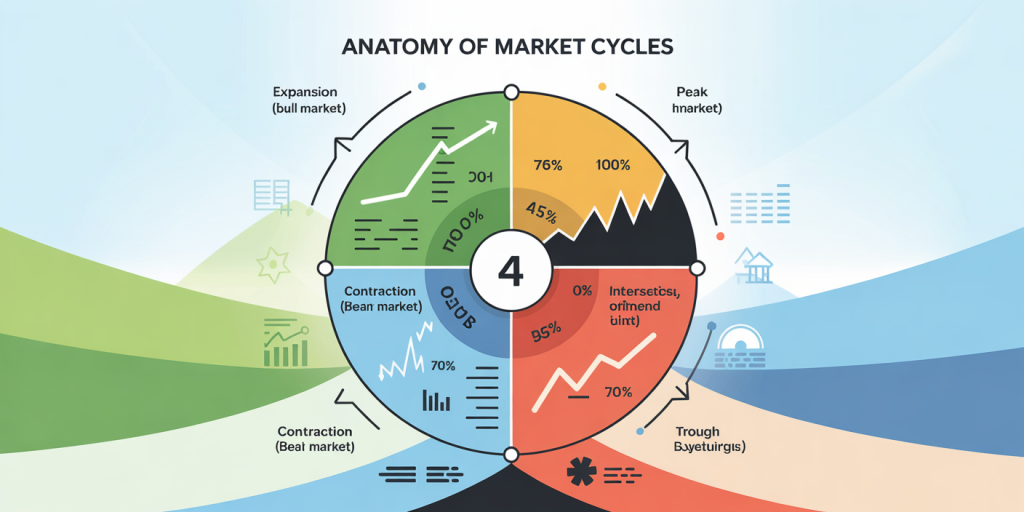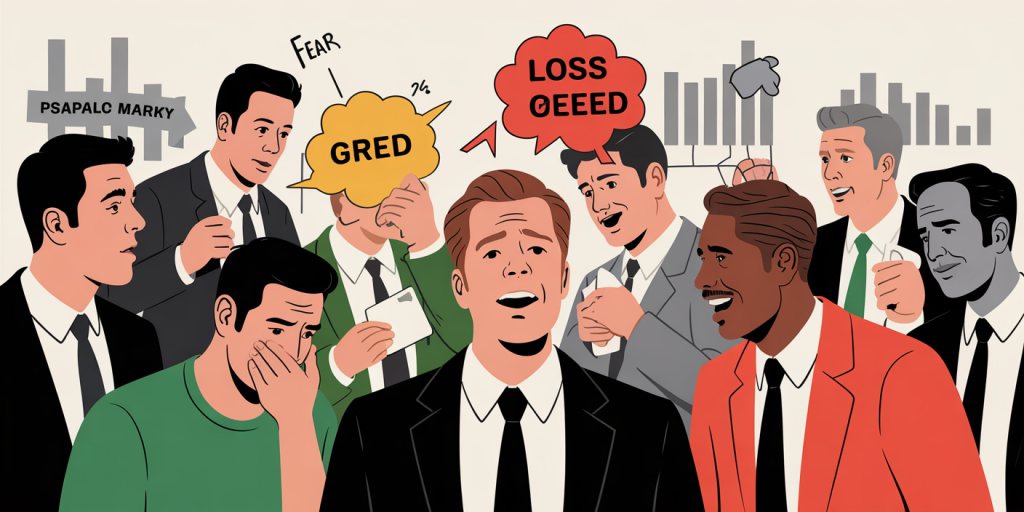Understanding Market Cycles: How to Stay Calm in Volatility
Financial markets are inherently dynamic, characterized by periods of growth, stagnation, and decline. These fluctuations, known as market cycles, often incite uncertainty among investors, triggering emotional reactions that can undermine long-term financial goals. Understanding these market cycles is crucial for maintaining composure during choppy times and making rational investment decisions. This article delves into the nature of market cycles, how to navigate volatility effectively, and strategies to remain resilient when the markets get tumultuous.
The Anatomy of Market Cycles
Market cycles reflect the recurring phases that financial markets or individual investments undergo over time. These phases generally consist of expansion (bull market), peak, contraction (bear market), and trough stages. Expansion is marked by rising asset prices, improved economic indicators, and general optimism. Conversely, contraction signals a decline in asset value, economic slowdown, and pessimism.

Historically, market cycles can last from months to several years. According to a study by the National Bureau of Economic Research (NBER), the average length of a U.S. economic expansion since World War II is approximately 58.4 months, while recessions average about 11 months. Equities, bonds, commodities, and other asset classes follow their own cycles, often influenced by economic fundamentals, investor sentiment, geopolitical events, and monetary policies.
For example, during the 2007–2009 financial crisis, global markets entered a severe contraction phase characterized by significant drops in asset prices, widespread fear, and liquidity crises. Contrarily, the decade-long bull market from 2009 to 2020 was marked by steady economic growth, low unemployment rates, and increasing corporate earnings, reflecting an expansion phase. Recognizing where the market stands in its cycle can prevent impulsive investment decisions triggered by emotions like fear or greed.
Common Causes of Market Volatility
Market volatility is the degree of variation in asset prices over short periods. It can be spurred by various factors ranging from economic changes to geopolitical tensions. Understanding these drivers helps investors contextualize sudden market swings.
Economic data releases such as GDP reports, employment figures, or inflation rates can prompt traders to reassess market expectations. For instance, in May 2022, unexpected inflation data led to significant volatility in stocks and bonds as markets anticipated aggressive interest rate hikes by central banks. Similarly, central bank policies, like the Federal Reserve’s decisions on interest rates, impact borrowing costs and risk appetite, triggering market reactions.
Geopolitical events such as conflicts, trade negotiations, or pandemics have also historically caused sharp market fluctuations. The COVID-19 pandemic in early 2020 is a prime example; global markets plunged rapidly due to uncertainty but recovered over time as stimulus measures and vaccines emerged. Other causes include corporate earnings surprises, regulatory changes, and technological innovations that reshape industries.
Comparative Table: Common Causes and Effects of Market Volatility
| Cause | Description | Typical Market Reaction | Example |
|---|---|---|---|
| Economic Data Releases | GDP, inflation, unemployment rates | Short-term price swings | May 2022 inflation-driven sell-off |
| Central Bank Policies | Interest rate adjustments | Sector rotation, leveraged asset volatility | Fed’s 2013 taper tantrum |
| Geopolitical Events | Wars, trade disputes | Broad market declines or rallies | 2020 COVID-19 pandemic crash |
| Corporate Earnings | Profit reports and forecasts | Stock-specific volatility | Apple’s earnings surprises |
| Regulatory Changes | Law or policy shifts | Industry-wide impacts | GDPR impact on tech firms |
Understanding these factors helps investors frame volatility as part of normal market behavior rather than a signal to panic.
Psychological Impact of Volatility on Investors
Volatility affects not only asset prices but also investor psychology. Behavioral biases frequently exacerbate market cycles, leading to irrational decisions. Two of the most common biases are loss aversion and herd behavior.

Loss aversion refers to investors’ tendency to feel the pain of losses more intensely than the pleasure of gains. This bias often results in panic selling during downturns, locking in losses rather than holding for recovery. For example, during the 2008 financial crisis, many retail investors liquidated their portfolios at the bottom, missing out on the subsequent recovery that led to the longest bull market in history.
Herd behavior causes investors to follow the crowd, buying during euphoric bull markets and selling during panic-filled bear markets. This mimetic behavior amplifies price swings and can cause bubbles or crashes. The dot-com bubble of the late 1990s exhibited such mass buying of technology stocks based on speculation rather than fundamentals, followed by a painful market correction.
Acknowledging these psychological tendencies is the first step toward controlling emotional reactions. Investors who adopt a disciplined approach are more likely to ride out volatile phases without derailing their long-term objectives.
Strategies to Stay Calm During Market Volatility
Remaining calm during volatile periods is essential for successful investing. Below are several proven strategies that help investors maintain discipline and make informed decisions under stress.
Diversification and Asset Allocation
Diversifying investments across various asset classes, sectors, and geographies reduces exposure to any single source of risk. Balanced portfolios with a mix of stocks, bonds, real estate, and alternative assets tend to dampen fluctuations. Asset allocation aligned with one’s risk tolerance and time horizon is crucial for weathering market cycles.
For instance, during the 2020 market crash, investors with bond-heavy portfolios experienced less severe losses compared to equity-heavy portfolios. According to Vanguard, a 60/40 stock/bond portfolio lost roughly 14% at the market low, whereas an all-stock portfolio fell over 33%. Such diversification cushions volatility and reduces the urge to react impulsively.
Setting Clear Investment Goals
Clear, long-term investment goals help investors adopt a strategic perspective rather than focus on short-term market noise. Whether saving for retirement, education, or wealth accumulation, predefined targets guide appropriate risk-taking and timing decisions.
Consider Warren Buffett’s advice: “The stock market is designed to transfer money from the active to the patient.” Patient investors who stay committed to their goals despite turbulence tend to achieve superior results over time.
Dollar-Cost Averaging
Dollar-cost averaging (DCA) involves investing fixed amounts at regular intervals regardless of market conditions. This approach reduces the risk of poor timing by spreading purchases across different market levels, lowering the average cost per share.
During volatile phases, DCA helps investors take advantage of price dips without trying to predict market bottoms. A 2019 Fidelity study revealed that consistent investing through market ups and downs leads to stronger long-term gains than lump-sum investing for many investors.
Avoiding Constant Market Monitoring
Constantly tracking market movements can heighten anxiety, leading to rash decisions. Limiting portfolio reviews to quarterly or semi-annual intervals encourages focus on the big picture. Utilizing automated alerts and professional advice can replace emotional reactions with measured responses.
Case Studies: Lessons from Past Market Cycles
Studying past market cycles provides actionable insights on managing volatility. Two notable cases illustrate how staying calm pays off.
The 2008 Financial Crisis
During the global financial crisis, markets plunged by over 50%, and many investors panicked. However, those who held steady or increased equity exposure during the downturn reaped considerable benefits. The S&P 500 index rebounded over 280% from its March 2009 low through 2020, rewarding patient investors.
Institutions like the Yale Endowment Fund maintained diversified portfolios and disciplined rebalancing, enabling resilience and fast recovery post-crisis.
The COVID-19 Market Crash and Recovery
In March 2020, the S&P 500 fell about 34% in just over a month as the pandemic escalated panic. Yet, markets recovered rapidly thanks to massive fiscal and monetary stimulus, with the index reaching new highs by mid-2021.
Investors relying on DCA and holding diversified portfolios weathered the storm without drastic losses. This cycle demonstrated how geopolitical shocks, although severe, can be relatively short-lived.
Comparative Table: Market Recovery Post Downturns
| Market Event | Peak-to-Trough Decline | Recovery Time to Pre-Crash Level | Key Factors in Recovery |
|---|---|---|---|
| 2008 Financial Crisis | ~57% | ~4 years | Stimulus, regulatory reforms |
| COVID-19 Pandemic (2020) | ~34% | ~5 months | Monetary/fiscal support, vaccines |
These examples highlight the importance of maintaining a long-term view and not succumbing to short-term volatility.
Technology and Market Volatility: Tools for the Modern Investor
Advancements in technology have transformed how investors monitor and manage market cycles. AI-driven analytics, robo-advisors, and algorithmic trading bring real-time data and automated risk management strategies to retail and institutional investors.

For instance, platforms like Betterment and Wealthfront offer personalized asset allocation with automatic rebalancing, reducing emotional intervention. Additionally, sentiment analysis tools utilize social media and news data to identify market mood shifts early.
However, technology can also exacerbate volatility through high-frequency trading and misinformation spread. Awareness and cautious use of digital tools remain important to maintain a balanced approach in volatile environments.
Anticipating Future Market Cycles: Trends and Considerations
Looking ahead, several factors will shape future market cycles and volatility levels. The ongoing global economic recovery post-pandemic, rising inflation, interest rate normalization, and geopolitical tensions (such as between major powers) are critical influences.
Climate change and sustainability initiatives will increasingly impact investment trends, creating new growth sectors while challenging traditional industries. Technological innovations like blockchain, AI, and clean energy are poised to redefine market leadership, possibly contributing to sector-specific volatility.
Investors should remain adaptive, integrating scenario analysis and continuous learning into their strategies. Emphasizing diversification, maintaining liquidity buffers, and reviewing objectives periodically will be key to managing unpredictable shifts.
Furthermore, demographic trends—such as aging populations in developed countries—could alter market dynamics by influencing saving, spending, and investment behaviors. Policymakers’ responses to global debt levels and geopolitical risks will also affect market stability.
Understanding market cycles is an empowering tool that helps investors interpret volatility as normal rather than threatening. By embracing disciplined strategies, controlling emotional responses, and leveraging technological advances, individuals can maintain composure even amid market storms. As global economic and technological landscapes evolve, staying informed and adaptable will ensure investors remain resilient and positioned for long-term success.
